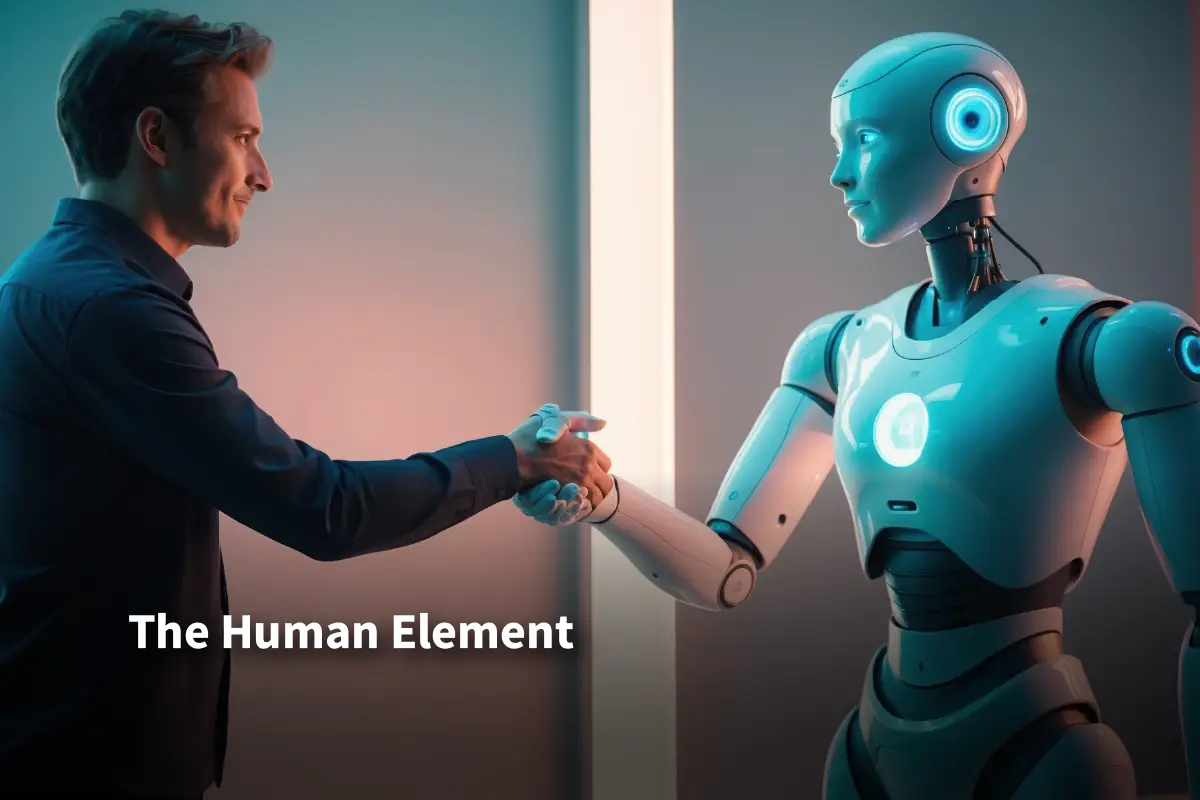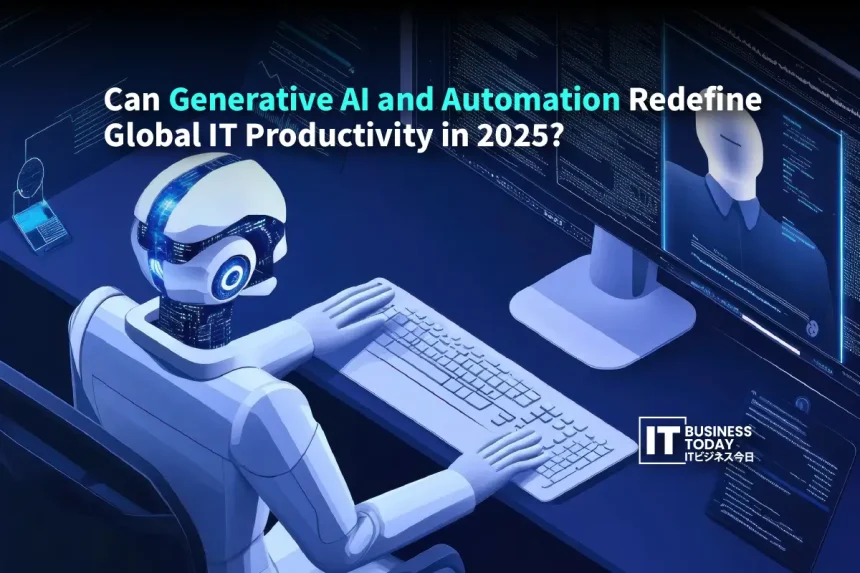何十年もの間、企業はグローバルITの生産性向上を目指してきました。そして、おなじみの手法に従ってきました。私たちはプロセスを簡素化しました。今ではアジャイル手法を採用しています。また、すべてを クラウド.一歩一歩の積み重ねが小さな成果につながっていくのですが、石から水を絞り出すような気分になることもしばしばでした。作業の核となる長いコード行、もつれたサポート・チケット、絶え間ないコンテキストの切り替えは、大きなボトルネックでした。今日、私たちは小さな変化ではなく、大きな変化の端にいます。ジェネレーティブAIとインテリジェント・オートメーションは、私たちのツールを変革しつつあります。それはまた、私たちが以下についてどのように考えるかを再構築しています。 生産性 ITで。
ビジネスリーダーにとって、これは見るべき未来ではありません。今すぐ利用できる現実なのです。問題は、このシフトが起こるかどうかではありません。2025年までに何が可能かを再定義するために、あなたの組織がどれだけ速く、賢く適応できるかということなのです。
すでに始まっている静かなる革命
ジェネレーティブAIを単なるチャットボットと見なすと、その真の力を見逃してしまいます。企業では 情報技術 世界では、IDEは強力な戦力となりつつあります。シニア開発者が真っ白なIDEを前にしていないところを思い浮かべてください。その代わりに、彼らはAIと働きます。このAIはコードモジュール全体を提案します。また、リアルタイムのエラー修正とセキュリティパッチも提供します。これには最新の脅威インテリジェンスが使われています。これはSFではありません。現実です。GitHub CopilotやAmazon CodeWhispererのようなプラットフォームがそれを証明しています。
初期のユーザーからは、開発サイクルタイムが大幅に短縮されたと好評です。例えば、GitHub Copilot のユーザーは、コーディング作業を約 55-56% AIがアシストしない場合と比べて、約3時間から1時間強の時間短縮を示した研究があります。より広範な分析では 33-36%デバッグ、テスト生成、コード・ドキュメンテーションなどのタスクで時間を節約できます。 ハッチワークス ジェネレーティブ・ドリブンによる30-50%の生産性向上を報告する組織もあると指摘しています。
こちらもお読みください: 日本におけるエンタープライズ・ストレージの将来性:データ集約の10年に向けたハイブリッド戦略
その影響は緑地開発だけにとどまりません。近代化 遺産 システムは大きな挑戦です。生成AIは何百万行もの古いコードを取り込むことができます。そして、そのコードが何をするのかを理解することができます。そして、ドキュメントを作成し、最新の言語に更新し、クラウドへの移行を計画します。これにより、ハイリスクで数年に及ぶプロジェクトが、スマートで管理しやすい計画に変わります。品質保証では、AI主導のテスト生成により、さまざまなテストを迅速に作成できます。これにより、人間のテスト担当者が数週間かけても見落としてしまうようなエッジケースを見つけることができます。これにより、QAはボトルネックから、開発プロセスの円滑で継続的な一部へと変わります。
負担のないイノベーションのエンジンであるオートメーション

ジェネレーティブAIは脳のように働き、考え、創造します。インテリジェント 自動化 は神経系であり、すべてを実現しています。現代の ITスタック は、クラウドサービス、オンプレミスのレガシーシステム、SaaSアプリケーションを組み合わせたものです。最初の波はRPA(ロボティック・プロセス・オートメーション)でした。RPAは反復的なルールベースのタスクの管理に優れています。コグニティブ・オートメーションは、AIによって推進される次のステップです。
アンケート調査 によると、44%の企業がジェネレーティブAIプログラムを試験的に導入しており、10%の企業がすでに本番稼働させています。現在、ITリーダーの約3分の1がAIを活用したワークフォースを利用しており、さらに次のような回答をしています。 44% 年内の計画採用
この強力なミックスは、単なるタスクのコピーにとどまりません。複雑なワークフローの管理にも役立ちます。AIはITサポートチケットを分析することができます。その意図と緊急性を理解します。次に、過去のインシデント・データをチェックします。そして最後に、人の手を借りることなく、AIが独自に解決スクリプトを実行します。これにより、すべてのIT部門が直面するティアワン・サポート・チケットの大きなバックログが解消されます。これにより、熟練したエンジニアは、ビジネス価値を高める重要なプロジェクトに専念できるようになります。
さらに、これはインフラ管理にも及びます。AIOpsプラットフォームは、システム障害を予測するタスクを自動化します。異常を発見し、リソースをスピンアップして予想される負荷を管理します。また、独自にセキュリティポリシーを実施することもできます。問題に対応するだけでなく、問題を予測することで、IT運用の生産性が大幅に向上します。ビジネス・エンジン・ルームを確実に稼働させます。最適化され、強固で、自己修復が可能です。
人間の要素

多くの人が、口には出さないものの、オートメーションによってITの仕事がなくなってしまうのではないかと心配しています。これは状況を根本的に見誤っています。目的は人に取って代わることではありません。むしろ、退屈な反復作業から解放することです。熟練したソフトウェア・アーキテクトの価値は、エラーのないコードを速く書くことだけではありません。戦略的ビジョン、ビジネスニーズの把握、そしてエレガントでスケーラブルなシステムを構築する能力です。ジェネレーティブAIは、構文を管理することでこの価値を高めます。これにより、アーキテクトは意味に集中することができます。
2025年のITチームの姿は大きく変わるでしょう。彼らのスキルは単純作業から価値の高い分野へとシフトしていくでしょう。
これには以下が含まれます:
- AIシステムをより良く機能させるための迅速なエンジニアリング。
- 品質管理のためのAIモデルキュレーション。
- プロジェクト管理のための戦略的監督
- 成長のための主要なビジネス・パートナーシップ
開発者がデバッグや定型的なコードを書くことに忙しくなければ、ステークホルダーにもっと集中することができます。これにより、開発者は顧客のペインポイントを明確に把握することができます。そして、ビジネスの課題に取り組むためのイノベーションを推進することができます。生産性の向上は、毎時何行のコードを書くかということだけではありません。ビジネス価値を高め、イノベーション能力を向上させるということでもあるのです。
実装の地雷原をナビゲート
その可能性にもかかわらず、この強化された未来への道には多くの課題があります。慎重なリーダーシップが不可欠です。
データのセキュリティと知的財産が最大の懸念事項です。独自のコードや機密性の高い顧客データを公開AIモデルに投入することは非常に危険です。解決策は、規律あるアプローチです。これには、厳格なデータガバナンス・ポリシー、強力なプライバシー保護を備えたトップクラスのAIソリューション、オンプレミスまたは仮想プライベートクラウドのセットアップの選択が含まれます。これらのステップにより、データを完全に管理することができます。
文化や変化の管理も大変です。成功に必要なのは、ソフトウェアのライセンスだけではありません。必要なのは、トップダウンによる再教育とスキルアップへの強いコミットメントです。組織は継続的な学習に投資すべきです。組織は、継続的な学習に投資すべきです。AIツールの実験を奨励し、それに報いる文化を作る必要があります。リーダーは、代替ではなく、昇格のストーリーを共有すべきです。リーダーは、チームが自分のキャリアで最も意義のある仕事ができるようにする必要があります。
最後に、過度の信頼は危険です。ジェネレーティブAIのモデルは、現実のように見える出力を作成することができますが、多くの場合、間違っているか、安全ではありません。これは「幻覚」と呼ばれます。このため、「人間がループに入る」アプローチが必要です。AIが作成したコンテンツを専門家がレビューし、検証し、編集します。AIは優れたジュニアアシスタントです。しかし、それでも人間の判断と説明責任が必要です。
2025年の生産性配当
今後2年間で成功する企業は、今この土台作りを始めた企業です。AIを活用したITへの移行は戦略的な旅であり、スイッチを切り替えることではありません。
ITワークフローの明確な監査から始めましょう。
- 最も摩擦が大きく、繰り返しの多い部分を見つけましょう:
- コードドキュメント
- レガシーシステム照会
- レベル1サポート
- テストケースの生成
これらはパイロットプロジェクトの有力な候補です。成功の可能性が高く、投資対効果が明確なユースケースを選びましょう。
セキュリティ、統合の選択肢、拡張性を考慮して技術パートナーを選びましょう。現在のDevOpsやITサービス管理システムと容易に統合できるプラットフォームを重視してください。
最も重要なことは、ビジョンを持ってリードすることです。自分の役割の将来について、今すぐチームを巻き込んで話し合いましょう。彼らの成長に投資しましょう。新しいツールの使い方だけでなく、問題解決に対する異なる考え方についてもトレーニングを提供しましょう。ジェネレーティブAIや自動化だけでは生産性は上がりません。従業員とテクノロジーがどのように協力し合えるかを再考する勇気あるリーダーが必要なのです。
2025年までに、トップIT組織の基準は劇的に変化するでしょう。生産性はもはやアウトプットだけでは測られず、戦略的インパクトで測られるようになるでしょう。この新時代の勝者は、AIの真の力が単に作業をスピードアップするだけではないことを理解するでしょう。それは、人間の才能に新しいものを生み出す力を与えることです。これにより、技術チームの革新的な可能性が最大限に引き出されるのです。ITの未来は、単独で働くことではなく、テクノロジーとともに働くことです。その未来を築くのは今なのです。







